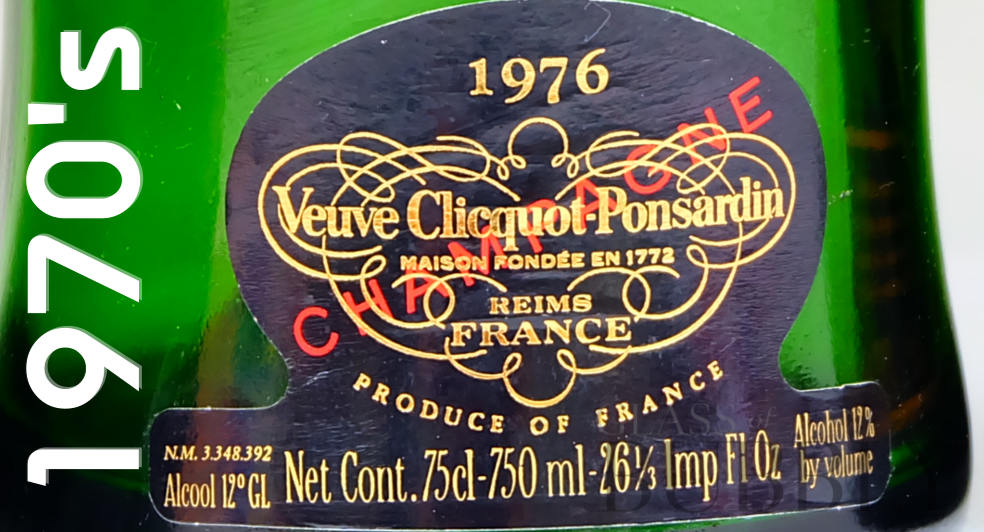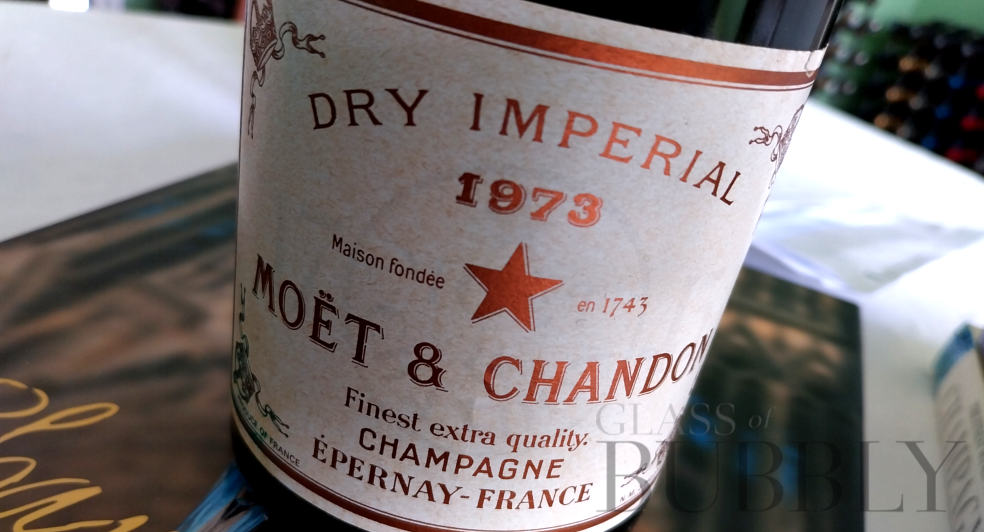Champagne Vintage Years: 1970’s
13th April 2023

The 1970’s delivered Champagne a decent handful of vintages. Though these years will be long past their peek performance levels, well at least to the standards of the then winemaker, they nonetheless prove to be much sought after today and offer a unique insight of taste/aroma profiles to what is now around 50 years of aging.
Relatively scarce in supplies and not readily available without a great deal of searching, using specialised fine Champagne merchants or warm connections within Champagne houses – A tasting of a 1970’s vintage Champagne is quite an occasion in being both highly educational and a fabulous experience. Champagne houses will from time to time release senior vintages such as those from the 1970’s and usually do so with PR backing, it can be an eagerly anticipated event such as Lanson’s (Vintage Collection) magnums of the 1979 disgorged in 2018 after 38 years on the lees! Other times a visit to the house will be required so to explore and purchase older non-disgorged vintages.
“I am very much intrigued by Champagne from the 1970’s both in that it is the decade I was born, though alas 1974 was not a fine vintage year, and the incredible flavours and aromas these wines deliver despite half a century of waiting patiently in the bottle. When it comes to older vintages, the importance of their storage history grows in that examples that have always remained in the house cellars will perform at 100% potential for its age whereas bottles that are corked and likely to have no history and possibly not stored in the best location(s) will most probably underperform. Nothing beats purchasing rare vintage Champagne direct from the house cellars.” Christopher Walkey
What exactly makes for a vintage Champagne? Though there is no overall official consensus as to what year will take on a title of vintage, neither are there standards set which have to be achieved, the decision is instead independently taken by each wine maker / cellar master of the Champagne houses themselves.
What exactly is a vintage Champagne? For those wondering what a vintage means, the explanation is quite simple – All the grapes used to make the Champagne were from the same year and to signify this a year will be stated on the bottle. Important to remember that though many vintages are old, the term ‘vintage’ in the world of wine does not mean ‘old’!
“The Champagne region is quite a sizable one so even though weather on the whole can be good or bad, this can vary from region to region so a vintage might not be declared by most wineries, but a few can buck the trend via pockets of finer weather and superior harvests.”
For sure, most top Champagne connoisseurs will say that any vintage from the 1970’s should be classified as ‘drink now’ over thinking about further aging, though to be honest when we have reached such an age in any wine, it is not so much performance, it is about the complexity and experience, the wine will be far beyond what it would have tasted like had it only ten to twenty years of age. 1970’s labels will appeal to historians and the enthusiasts of Champagne and though many Champagne Collectors like to snap up a vintage bottle of their birth year or similar significance, the decision to purchase a bottle is a more calculated one as prices are likely to be quite expensive!
Champagne Vintages 1970 – 1979:
1970: Some would say a near perfect year with plenty of sunshine and rainfall at the right time, most houses will have a vintage in 1970. Dom Perignon, Cristal (Rosé and Brut), Comtes de Champagne (Brut and Rosé), Veuve Clicquot Ponsardin Carte d’Or, Bollinger Brut Vintage and more.
1971: Summer arrived very late this year and prior to that weather was an array of temperatures and conditions including storms. Another near perfect vintage as quoted by many, 1971 gives us an abundance of choice from many Champagne houses with labels to look out for including Piper-Heidsieck Hors-Série, Dom Ruinart, Dom Pérignon, Charles Heidsieck Champagne Brut Royal, Cristal (Brut and Rosé), Comtes de Champagnes (Brut and Rosé) and Reserve Baron Philippe de Rothschild.
1972: Somewhat an out of favour vintage year with very low vintage labels to discover.
1973: Known for delivering an enormous harvest with a long, warm summer and only slightly marred by rainfall towards harvest time. Nearly a five star rating by most for this vintage and there is plenty of choice for experiencing what this year delivered and at the time of writing this article, this is a 5o year old piece of history! La Grande Année from Bollinger, Dom Pérignon, Krug Vintage, Dom Ruinart (and rosé), La Grande Dame (and rosé), Moët & Chandon, Deutz Cuvee William, Henriot Millesime, G.H. Mumm (Cuvee R. Lalou Prestige), Pommery, Charles Heidsieck and the choice rolls on and on.

1973 Moët & Chandon Vintage (Dry) Champagne
1974: Not usually recognised as a vintage year and usually left out when referencing the 70’s. Rosé seems quite popular in 1974 with Louis Roederer Cristal releasing theirs (also the brut), Pommery rosé, Krug Vintage Champagne Clos du Mesnil, Salon Cuvee ‘S’ Le Mesnil Blanc de Blancs Brut and Taittinger Comtes de Champagne Rosé.
1975: The year saw a later harvest in October with a relatively decent, long summer period. Most will rate this year highly as a vintage and plenty of houses agreed with magical labels produced to honour 1975 including Dom Pérignon P3, Pol Roger Cuvee Sir Winston Churchill, Perrier-Jouët Belle Epoque (Fleur de Champagne), Cristal, Krug, Comtes de Champagne and a long, long mouth-watering list continues…
1976: Given a five star review in many publications and online articles, the 1976 competes against the harvest of 1970 for the best of the decade. An early harvest was called in September following a long, warm summer. Plenty of houses have vintages including Dom Pérignon, Comtes de Champagne, Cristal (including rosé), Bollinger La Grande Année, La Grande Dame from Veuve Clicquot, Rare from Piper-Heidsieck and plenty more. By far one of the most exciting vintages to discover and open.
1977: Many of the big houses declared a vintage for this year including Cristal and Moët & Chandon (Special Silver Jubilee Cuvée). You can also find de Venoge, Dom Pérignon and Laurent-Perrier (Extra-Dry).
1978: Known for having a somewhat disappointing summer season with less than average temperature causing more acidity in wines and not much hope for greater length in aging. The 1978 vintage is classified as average at best, though many Champagne houses declared it fit for their prestige releases to include Dom Pérignon brut and rosé, Veuve Clicquot Ponsardin La Grande Dame Brut, Moët & Chandon Grand Vintage Brut, Crista, Bollinger, Perrier-Jouët and many more.
1979: Agreed by most for being a great vintage with a relatively late harvest despite records showing a worrying late frost in May time. “While the wines from this vintage should be consumed relatively soon, they remain some of the best examples of top-quality, long-aged Champagne.” source Christies. Most, if not all, Champagne houses threw their hat in to the ring with the 1979 vintage – Look out for 79’s of Bollinger Grande Année, Charles Heidsieck Champagne Charlie, Pol Roger Blanc De Chardonnay, Veuve Clicquot and many, many more.
Discussions on the Champagne Collectors Facebook group regarding vintages from the 1970’s include:
“Generally, greatest vintages are 79 (the most elegant and classic, like 88 and now 02), 76 (the hottest and most exotic, but aged beautifully like great 47, 59 and later 90), 75 (a bit darker than 79 and not that universally great, but there are many wonderful 75s that are still amazing today), 73 and 71 (really fun to have those 2 side by side, 71 is less oily and fat than 73, but has very distinctive structure and mouthfeel). 78 in Champagne was never that great as in Burgundy or Nothern Rhône, but some vinotheque wines are magical, especially rosé (think of Clicquot Cave Privée 78 rosé). 70 was a huge harvest, very diluted. Only some 70s are still great, like all wines from Bollinger (VVF and RD).”
“72 was a disaster, no vintage wines declared. 74 was also very difficult, but Roederer released Cristal (poor by Cristal standards, but still alive today!) and Cristal Rose (it is the first vintage for Cristal Rose, and actually very nice). 77 also poor year, very limited vintages declared (again Cristal and also De Venoge).”
Christophe Trouillard
“1972 very bad vintage – Harvest too late.”
“Grass smelly Champagne ! Forget it.”
Philippe Brun
“73 was a good vintage too…”
![]()
Christopher Walkey
Co-founder of Glass of Bubbly. Journalist and author focused on Champagne & Sparkling Wines and pairing them with foods.
